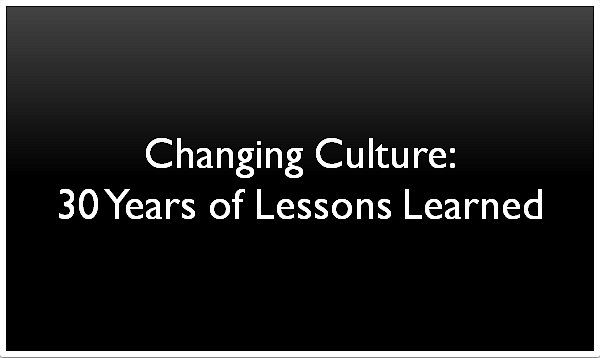
Strategies for Shaping Culture Part 2
Strategies for Shaping Culture Part 2
4. CREATE YOUR CULTURE PLAYBOOK – Make It Explicit
• Engage one group at a time For Ford’s culture turnaround, former CEO Alan Mulally started with his Executive Team and then engaged Product Design. In most companies, the development of a playbook for strengthening the 1-2 culture priorities starts with identifying the practices, norms of behavior and beliefs that the Executive Team commit to work on for the coming months – their Culture Playbook. They then sponsor the development of Culture Playbooks with each of their leadership teams who then engage their own teams. In this way inter-connected Playbooks develop that reflect local practices and norms of behavior but align with enterprise priorities.
• Use new practices to send signals that something needs paying attention to Changing a long established routine that is locking in the old culture and impeding development of new culture strengths can send signals across the organization. For example, at IBM in the 1990’s, monthly reports were cleansed of any incomplete or failed activities. Executives were in the dark. The reports were cancelled and replaced by a new, more transparent approach to monitoring that shocked many. At Ford, Mulally introduced a simple red, yellow, green scorecard for monitoring goals and then had the team work hard at reviewing progress using objective data, without blame fixing. Some changes to routines are signals, some are significant and create upheaval, while others support incremental change. Choose which strategy is needed knowing that transformational change does not come without pain.
• Accelerate by focusing on high-leverage inter-related practices Use day-to-day practices and routines to encourage valued behaviors, beliefs and assumptions. For example, for a team wanting to improve execution discipline, this may mean having a Monday morning cross-departmental meeting (a practice) to coordinate work, a Friday team conference call to review progress (a practice) and a monthly feedback session (a practice) to discuss improvements that could be applied to next month’s work. Each of these managing practices focuses on the same two behaviors: being accountable and using constructive feedback, creating the opportunity to rapidly grow capability together. Consider inter-related changes to managing, operating, social or organizational learning practices that will lead to desired beliefs and behaviors.
• Focus on the critical few Anyone who has tried to diet or become more fit knows how difficult it is to change habits and routines. Work with leaders and their teams to develop no more than 4-6 specific action strategies (see example above) for the coming three months. List week by week what this will look like in action. When it gets too complex, strip it down and make it more targeted. Roll the plans forward with weekly, monthly and quarterly check-ins. The result of this is a Culture Playbook that is owned by the team that they can measure progress against.
• Provide support Working together on strengthening culture is something new for many groups. Facilitation support may be needed to help identify new kinds of practices and related behaviors and also work through beliefs and assumptions no longer relevant to the future, however, groups usually take ownership of managing their Playbooks quickly. Having a facilitator work with the team every three months on assessing progress, what was learned about culture development and what is next can also be valuable support to accelerate culture change.
5. USE THE AMPLIFYING EFFECT OF LEADER BEHAVIORS – Role models
• Role model desired behaviors Like ripple effectives on a pond, leader behaviors shape the culture of the organization. Leader behavior tells us what is desired and valued. Help managers lead the way. Invest in leadership meetings, development programs and coaches to improve self-awareness and develop competencies to support the desired culture. This may be having panel discussions during which top leaders share what they are learning about a culture priority such as agility or collaboration, or a global webinar where different levels of employees share what they are doing differently, or team stories to download and discuss at meetings which demonstrate the desired culture in action.
• Create a feedback rich environment Use self-assessment, round tables, surveys and feedback sessions to help people understand how their behaviors are perceived by others and what the consequences are of specific behaviors. Focus feedback on strengthening capability for the desired culture and specifically the culture priorities rather than generalities.
You’ll notice we haven’t talked about how to make your culture change stick. That’s our next blog. But if you want to shape your culture proactively, find one or two points in this blog to experiment with and get going!









